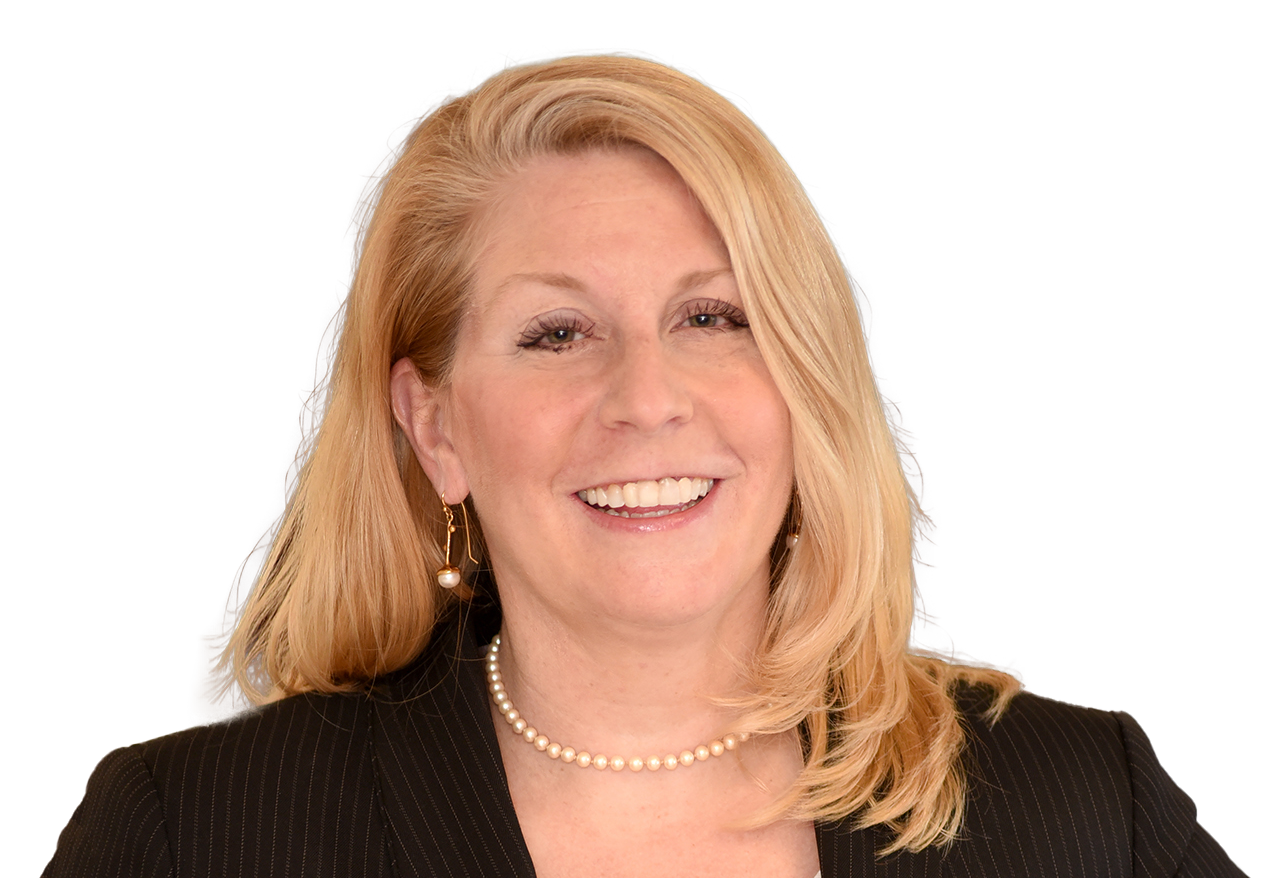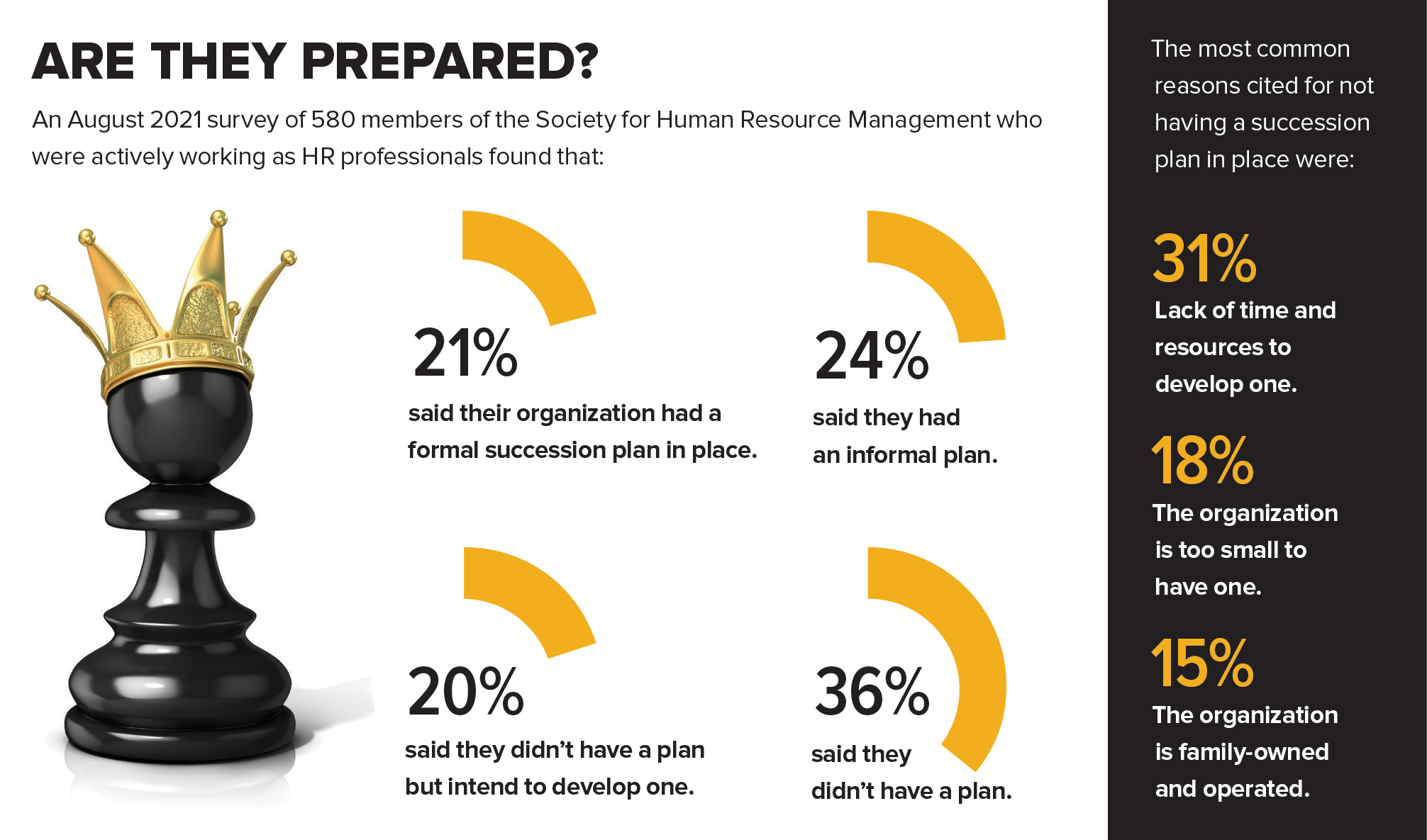Succession Planning Is Critical in Uncertain Times
Plan ahead to transfer knowledge and retain employees in key roles.
In a previous HR position for a global mining company, Cady O’Grady, SHRM-SCP, discovered that half of the company’s employees—sales and administrative personnel, technical experts, and executives—were eligible for retirement within three years.
Specialized talent was hard to find in the mining industry in 2008; O’Grady and her leadership team had been concerned about the shortage of new talent for a while. And although the company had made some progress filling positions, challenges remained. Among them: Fewer college students were majoring in mining, and regulatory and environmental requirements on companies were discouraging people from pursuing jobs in the industry.
O’Grady and her team ended up looking to similar industries—steel and paper services—to find individuals with transferrable skill sets so the company could then grow its own talent.
“The people strategy was more challenging, but it was well worth it,” O’Grady recalls. “We had the opportunity to think more innovatively, and we were very successful in that process.”
Nevertheless, the situation taught her the value of having a succession plan in place, she says.
A High-Stakes Game
Succession planning is a bit like chess in that HR professionals must assess the board with an eye on the next move—and the next five moves thereafter. If one piece falls, the individual must develop a winning strategy using the pieces that remain.
Many organizations don’t think about succession planning until someone retires or dies.
“Then the company is operating in a crisis situation, which leads to poor decisions,” says Mary Kelly, chief executive officer of Productive Leaders, based in Dallas, and co-author of Who Comes Next? Leadership Succession Planning Made Easy (Productive Leaders, 2020).
In today’s environment, where many employees are retiring as soon as they become eligible and employees of all ages are jumping ship after a rough period characterized by pandemic-related changes, having a succession plan is more important than ever.

“Ten thousand Baby Boomers retire daily, and somehow companies are surprised by this,” Kelly says.
In addition, a near-record 4.3 million U.S. workers quit their jobs in December 2021, according to the U.S. Bureau of Labor Statistics. From January through November 2021, 1,231 CEOs left their posts, an increase of 1.1 percent over the 1,218 CEOs who did so through the same period in 2020, according to Chicago-based outplacement firm Challenger, Gray & Christmas Inc.
Jackie Anderson, HR director at RMI, a 180-employee transportation and warehousing company in Mattawan, Mich., has been watching these trends closely—even though her employer is family-owned and operated.
“If something happens to the CEO, our VP of operations is also a family member and would take over,” Anderson says. “We’re currently putting a succession plan into place for the rest of our executive team. I’ve asked each manager to look at key positions and say, ‘If this person walked away, what would happen?’ I know who my successor would be, but my finance person probably wouldn’t.”
Assess Roles
In an August 2021 survey of 580 members of the Society for Human Resource Management who were actively working as HR professionals, 56 percent said their organization didn’t have a succession plan in place. Only 21 percent reported having a formal plan, while 24 percent said their organization had an informal plan.
The first step in developing a succession plan is to determine which roles to focus on.
Alex Clark, SHRM-SCP, HR director for Sonstegard Foods Co. Inc., a 450-employee egg producer in Sioux Falls, S.D., breaks job roles into two categories: short term and long term.
“For short-term needs, I like to use a triage approach and identify the critical activities our locations need to operate day-to-day,” Clark says. “If the product cannot be made, sold and delivered, the business won’t have customers or revenue.”
To meet the long-term needs of the business, it can take years to internally develop employees who will execute the company’s strategy and future vision, he says.
Many business leaders believe succession plans are needed only for executives. However, O’Grady, now director of HR for Greensfelder, Hemker, & Gale PC, a St. Louis-
based law firm with 260 employees, has a succession plan for every position in the organization. “If an organization is communicating that only senior leadership positions have succession plans, it sends the wrong message that some people are valued more than others,” she says.
Still, unique roles will likely require more-complex succession plans. While all employees are important, not all jobs are key.
“For instance,” RMI’s Anderson says, “if a driver doesn’t show up for work or leaves the company, we have 90 other drivers who can bridge that gap. But our planning department is lean. If a planner decided to leave our company, we can’t take anyone from any other department to do that job, and it would leave a huge hole in our company.”
At Sonstegard Foods, the HR team has identified key positions that are critical to the company’s operations, such as dryer operators and plant maintenance workers who know how to make the product and maintain specialized equipment. These individuals need an aptitude for mechanical, electrical, pneumatic and computer systems.
“They have to be well-rounded in multiple crafts to move 6 million eggs a day from the barns to the cartons and turn liquid egg into a dry powder that meets precise quality, customer and regulatory specifications,” Clark says.
“Their skills and knowledge make them critical to retain because of the difficulty to find competent people in competitive environments, and also essential to cross-train with multiple colleagues to ensure coverage during lean times,” he adds. “The goal is for everyone to have identified replacements to fill in for any vacancy, vacation or leave.”
 Find Candidates
Find Candidates
The second step in succession planning is to identify who might be capable of stepping into new roles if employees in key positions leave the company.
“Who is ready now?” O’Grady says. “Who would be ready in one to three years? Three to five years? Identify what types of tools, training and knowledge [you] would need to share in order for individuals to be ready to become a successor.”
At the law firm, “we do a talent review process to identify the breadth of talent across the organization,” O’Grady says. “We have a lot of individuals with highly technical expertise that can’t be learned overnight. We build in plans for more-tenured individuals to do a knowledge transfer to the next generation, even if they aren’t leaving the organization or being promoted anytime soon. It’s important to build a culture where knowledge is shared, rather than just being held by one individual. Constantly share knowledge and information.”
RMI’s Anderson emphasizes the importance of including the identified employees in the planning process.
“Interview the succession candidates to see what areas they want or need to develop and if they have an interest in fulfilling the role,” she says. “I’ve had employees who don’t want to be leaders. I had one employee who stepped into a sales manager position and hated it. His sales were declining, so I asked him what was happening. He said he hated being a manager. We put him back into a sales position, and he excelled again.”

Capture Knowledge
After managers have determined who might be suitable for roles, it’s crucial to provide those candidates with training and development opportunities. This might include participation in mentoring, job-rotation, job-shadowing or cross-training programs; attendance at conferences; or enrollment in educational courses.
“We like to do rotations, which can help individuals learn from others,” says Amy Jo Young, senior director of organization effectiveness for defense systems at Northrop Grumman Corp., an aerospace and defense company headquartered in Falls Church, Va., with 90,000 employees.
Cross-training is essential, many experienced HR professionals say.
“Make sure leaders aren’t hoarding information and are involving those who may be tapped to lead in the future,” says Anthony T. Eaton, HR advisor at pharmaceutical distributor AmerisourceBergen in Irving, Texas, which has 25,000 employees. “Ensure there is a level of inclusion and delegation,” he advises. “For example, when a leader takes extended PTO [paid time off], have the identified successor step into the role and lead in their absence.”
When you know someone is leaving, ensure that the departing employee is working with a potential successor to transfer all pertinent knowledge about the role.

“Don’t wait until the last minute,” Young says. “Right now, we have someone who has been working on a program for some time and that employee is retiring in a couple of months. We have named the successor, and they are working together to meet the customers [and] key stakeholders and learn about the contract.”
What should HR professionals do if an employee resigns unexpectedly?
“If you find out Bob is going to leave and no one was planning on him leaving, the head of HR needs to get somebody from outside [his team] to shadow Bob for three days and take notes,” Kelly says. “Every meeting, every conversation needs to be captured and mapped out.”
Why is it critical to document the transfer of knowledge?
“If you ask Bob, who has been in the job for 20 years, how to do his job, it would be akin to asking him to explain breathing,” Kelly says. “He’s been doing it so long he can’t recognize what he does.”
Kelly spent 25 years in the U.S. Navy, where individuals are given new job assignments every two or three years. Despite the frequent changes, the Navy maintains a high degree of readiness and effectiveness. According to Kelly, that’s because “every single person prepares the next person to take over the job. You prepare a binder to brief that person about everything they need to know about the job and leave the binder on the desk with your cellphone number. Everybody takes responsibility to share institutional knowledge for the good of the organization.”
One way Northrop Grumman captures institutional knowledge is by engaging in storytelling and videotaping it. “It helps us capture historical perspective and leverage procedural information that’s critical to the program,” says Young, who adds that the videos are used as a reference and that security concerns are kept in mind.
“We will have employees sit down with a group of people to share information, and we videotape it or they videotape themselves talking into the camera to dive into some details whenever we need them,” she says.
Plentiful Replacements
Succession planning is an ongoing, evolutionary process.
“Have a process in place for regular review of succession plans and the associated development for those who have been identified as potential successors,” Eaton says. “Are they being groomed to take on a role?”
Experts also advise HR professionals to communicate regularly with potential successors.
“Stay connected with your employees,” O’Grady recommends. If succession candidates are considering leaving, HR professionals need to know so they can determine whether it’s possible to offer enticements, such as a more flexible work schedule, to retain individuals whose needs might have changed.
“With the amount of turnover happening presently, making sure there’s depth on the bench is critical,” Clark says.
Preparing multiple succession candidates for each key position gives the company maximum flexibility, which is vital in today’s fast-changing environment.
Revisit succession plans on a quarterly basis. Life changes drive job changes and, thus, vacant positions, so consider the personal situations of the employees involved: Who is retiring, getting married, having children, graduating with advanced degrees, losing parents or experiencing serious health challenges? Also determine who needs mentoring, job rotations or additional training, and then ensure managers have what they need to develop capable replacements for their teams.
After all, planning now prevents future panic.
Kathryn Tyler is a freelance writer and former HR generalist and trainer in Wixom, Mich.
Illustrations by Djmilic/iStock.

AVOID THESE COMMON BLUNDERS
The biggest mistake in succession planning is the failure to plan at all.
“It’s critical for companies to do succession planning, but oftentimes they don’t,” says Jackie Anderson, HR manager at RMI, a transportation and warehousing company. “For instance, owners might feel they aren’t ready to retire for another 10 years, but then something unforeseeable happens and the company stalls. All key positions need to have succession plans.”
Other common blunders include:
Failure to set reasonable employee expectations. Communicate the importance of an individual’s contribution and place within the company. Make sure employees know where they stand and that they’re valued by the organization, says Cady O’Grady, SHRM-SCP, director of HR at Greensfelder, Hemker, & Gale PC.
Failure to seek employee input. Ask employees what they want. Some employees might not wish to be promoted to a manager position. “Every single person in the organization needs to know where they’re going next,” says Mary Kelly, chief executive officer of Productive Leaders. “If they want to move up, what do they need to do to be successful?”
Failure to be inclusive. Steer business leaders away from selecting successors who resemble themselves, advises Alex Clark, SHRM-SCP, director of HR for Sonstegard Foods Co. Inc. This type of bias can stifle new perspectives that others in the organization could bring.
Failure to thoroughly vet potential successors. “Some of the more common mistakes I’ve observed are to fail to go deep enough on the talent reviews and to overrate people too early in their careers,” says Amy Jo Young, senior director of organization effectiveness for defense systems at Northrop Grumman Corp. “They might be rock stars out of college and you put them on a succession plan, but they’re outstanding technically, not necessarily as leaders.”
Failure to have enough candidates. Don’t rely on the same person as a successor for four different roles. “That’s not healthy bench strength,” Young says. “You need to have a variety of people at a variety of readiness levels for those roles.”
Failure of leaders to take an active role. As with most projects, success can only be achieved when organizational leaders provide strong and vocal support. “Most companies dump it in HR’s lap and say, ‘You deal with it,’ ” Kelly says. “HR’s job is to help leaders to manage talent, not be the doer in all things. HR’s job is to make sure managers have what they need to guide and lead their people.” —K.T.


